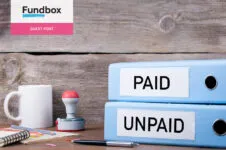One of the downsides of freelancing is the risk that your client won't pay on time and is seemingly unreachable. Here's what to do if a client doesn't pay.

Freelancing has its perks—the freedom to work from home, choose your own hours, and not brush your hair for days.
But of course, with running any small business, the good comes with the not-so-good. Besides not having the security of a traditional job, one of the downsides of freelancing is the risk that your client won’t pay on time and is seemingly unreachable.
In the dating world, when someone stops calling and seems to have fallen off the radar completely, it’s referred to as “ghosting.” As you can imagine, getting ditched by last night’s dinner date is disappointing, but it isn’t nearly as traumatic as being ghosted by a client you’ve sent several unanswered invoices to.
Table of Contents
Your Options If a Client Doesn’t Pay You
1. Don’t Jump the Gun
Whether it’s dating or freelancing, it’s easy to expect the worst. For one, you can’t help but think you’re down hundreds of dollars simply because you haven’t received a reply from your client—especially if you’ve been burned in the past. However, you mustn’t conclude your client is trying to ghost you if you aren’t entirely sure. Accusing a client of racking up a hefty bill and ghosting you can potentially destroy the relationship and cause you to lose the job completely.
Keep in mind there are perfectly legitimate reasons that someone may not respond right away—perhaps they’re on a lengthy vacation or attending to personal matters. If your client hasn’t established a habit of disappearing, they may deserve the benefit of the doubt at least once, so give them a reasonable amount of time to respond before you start the chase.
2. Resend Invoices and Follow Up
Before invoicing your client, have an established agreement outlining when and how you should be paid for your work. It’s best to make it as easy as possible for the client. If they can pay you by simply clicking a button or replying to an email message, there’s a better chance you’ll get paid faster. If you aren’t getting paid or you haven’t received a reply to your invoice, resend the invoice as a reminder.
The invoice reminds them of the outstanding balance and, because it’s automated, it doesn’t appear like you’re personally strong-arming the client. If you sent invoice reminders and they still haven’t paid, follow up with a polite and professional email.
3. Contact via Social Media
Again, like dating, you fear that maybe your client isn’t receiving your emails or your outbox has ceased sending important follow-ups. If you re-sent invoices, reminders, and emails, you might have to resort to another form of communication to give yourself some form of peace of mind.
Most companies can be found on Facebook, Twitter, LinkedIn, or in some online capacity. Contact them through these venues with a simple, polite message to get in touch with you. While being ghosted is never a pleasant experience, it’s important to maintain professionalism—primarily since you’re representing your business as well.
4. Send an Attorney’s Letter
If your clients are still MIA at this point, you should have an attorney draft a letter. Sometimes the idea of legal action can get the client to contact you and, at the very least, arrange to pay what they owe. You can pay an affordable fee for an attorney letter, or you can inquire through freelance forums. If you’re really in a bind, you may also want to check with legal aid attorneys.
5. Small Claims Court
As a last resort, consider small claims court. However, these options cost money, so it’s important to weigh how much the client owes you against the expenses of following up. If the numbers just don’t make sense, it might be best to cut your losses and move forward.
Your Client Contacts You, Now What?
If your client finally contacts you and pays what they owe, you can consider the case closed and a lesson learned. From there, decide the terms that must be in place for the future. Under no circumstances, however, should you continue to provide the client with any services until outstanding invoices are paid.
Moving Forward
Whether your relationship ends or continues with the client, it’s a good idea to set some new rules going forward.
- Make it a requirement for a prepayment or a retainer for work, especially for more significant projects.
- Increase the frequency of payment based on milestones rather than dates. This way, you’re able to complete a comfortable amount of work and ensure you’re paid before you proceed.
- Have legal contacts and a plan in place in the event a client disappears. It’s easier to deal with it if you take care of all the research before it happens.
Protect yourself to ensure you get paid at the end. Read through a potential client’s contract details—it can go a long way when it’s time to get paid. Here, you can address any concerns: payment dates and work expectations and make any changes before starting. It’s also a good idea to have a contract template of your own to send to the client if not provided for you.
Like dating, there are obvious signs that a person can’t be trusted or counted on. In the excitement that comes with landing a gig, especially a lucrative one, it’s easy to ignore the signs. In both relationships and careers, if something seems too good to be true, it might be. Until you know for sure, it’s usually best to proceed with caution, if at all.
This post was updated in November 2021

Written by Christina Majaski, Freelance Contributor
Posted on October 30, 2020

 Yea or Nay: How to Decide Whether a Project is Worth Taking
Yea or Nay: How to Decide Whether a Project is Worth Taking It’s Time to Get Over the Fear of Money Talk
It’s Time to Get Over the Fear of Money Talk Should You Charge Late Payment Fees on Invoices?
Should You Charge Late Payment Fees on Invoices?





![12 Silly Invoicing Mistakes That a Cloud Accounting Solution Will Save You From Making [Infographic]](https://www.freshbooks.com/blog/wp-content/uploads/2017/11/invoicing-mistakes-1-226x150.jpg)